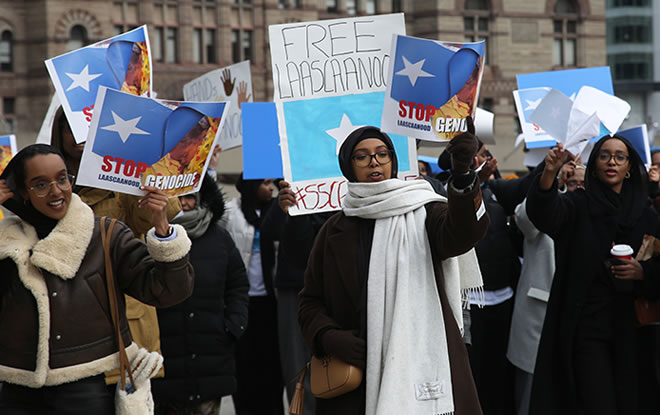by Osman Hassan
Monday June 5, 2023

The International Crisis Group (ICG) has recently issued a long statement on the fighting between “Dhulbahante and Somaliland” for the control of the town of Las Anod. Entitled “Time for Somaliland and the Dhulbahante to Talk”, this statement carries two contentious messages. The first is that “the Dhulbahante wants to join Somalia rather than be part of Somaliland”. The second is that the two sides should “agree to a ceasefire and prepare for overdue talks on the Dhulbahante’s administrative status.” This rejoinder to the ICG statement will dwell on and debunk these points.
The second ICG message, for ending the fighting, is one calling for administrative concessions to the Dhulbahante “grievances” to foreclose their “separatist quest to “want” to be part of Somalia. Needless to say, this premise that the SSC regions are “part of Somaliland”, albeit “want” to be part of Somalia, is false. As the Dhulbahante would say -and what they say counts more than what ICG surmises- they are not part of “Somaliland”, and never want to be part of it. Bearing all these in mind, the ICG proposed solution is once again politically motivated and aimed to maintaining the status quo in which “Somaliland” remains a separate (independent ?) county, and by implication legitimizes its occupation of the unionist northern regions, above all the SSC.
ICG solution is both partisan as well as unrealistic. It overlooks the deep unionist nationalist hallmark of the Dhulbahante psyche and the incalculable price they paid for it historically and in the present struggle. ICG wrongly assumes that once the amenable Dhulbahante are offered token “administrative” concessions, they will forsake their unionist aspirations and so remain part of “Somaliland”. Such false assumptions demean their 32 years of resisting the secession, the sacrifices they paid, in particular during the current ongoing costly and painful fighting in Las Anod.
The ICG pro-Somaliland stand goes beyond this current statement and permeates its overall coverage of the area. That bias is conspicuous from the speech by Louise Arbour, President and CEO of ICG at the time, to the Carnegie Council for Ethics in International Affairs, 22 September 2010. Her key note was that any “insistence by the African Union on the increasingly abstract notion of the unity and territorial integrity of the Somali Republic, with Somalilanders governed again from Mogadishu, is both unrealistic and unsupported by more than twenty years of state practice...”
Following on her footsteps, the ICG issued a report on Somaliland in 2006
recommending that the African Union offer it an “observer status”, as a reward it for “creating stability and democratic governance out of a part of the chaos that is the failed state of Somalia.”. Once an observer, the next step is full membership as the ICG no doubt contemplated.
ICG chose to largely ignore the historical aspects of the contention between the warring parties in Sool. It revolves around the genesis of the Somali State, born of the collective decision of the five clans of British Somaliland to unite with their sister territory, Italian Somaliland, once both gained independence. And so they fulfilled their aspirations in which no one northern clan forced others to join the union just as no clan has the right to force secession on the other clans.
That’s what the Isaaq clan did when their rebel militia, Somali National Movement (SNM), unilaterally declared on 18 May 1991 the secession of the northern regions (former British Somaliland) from the rest of Somalia (Italian Somaliland) and imposed the secession and their hegemony on the other four unionist clans who found themselves recolonized once again, this time by a fellow clan.
The fighting in Sool/Las Anod is the epitome of the struggle between on the one hand the occupied unionist clans defending their inalienable constitutional and fundamental human rights to be free and remain part of Somalia. And on the other hand their occupier, the Isaaq clan, masquerading as the self-appointed custodian of “Somaliland”, who will stop at nothing to maintain their hegemony as we see what they are doing to Las Anod.
Almost all SSC lands have been liberated and the occupying secessionist militia now holed in their last ditch at Gooje Adde, surrounded on all sides, and all supplies to them cut. Their anticipated surrender would be analogous to the French defeat in Dien Bien Phu in Vietnam in 1954. Under the circumstances, offering the Dhulbahante an “administrative adjustment” within “Somaliland” sounds out of place.
As Garaad Jama Garaad Ali, the paramount leader of the Dhulbahante clan, reiterated, the problem they have with the Isaaq is similar to someone invading your home, holding a gun at your head, and demanding subjugation to him. Somali conflict resolution would demand that the invader first withdraw to his home/land if peaceful dialogue is to take place It is a principle that’s compatible with all human rights conventions and the UN Charter. The ICG should revise its “Somaliland” perspective.
Osman Hassan
[email protected]